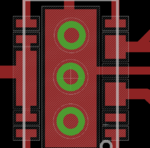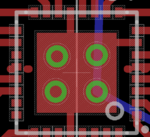leolib2004
Junior Member level 3
Hi,
I used Eagle to do my board and now that I finished I sent my gerber files to 4PCB. I used freeDFM but I get these results:
Insufficient SMT Soldermask Clearance (100 violations)
Requirements:We require a minimum of .003" soldermask clearance. This is achieved by a soldermask relief .006" larger than the associated copper pad.
Resolution:While too small a relief can cause your pads to be partially covered by soldermask, too large a clearance can cause traces to be exposed, causing problems during assembly. The best method is to set all your soldermask reliefs .006 in. larger than their associated pad.
It was automatically fixed and I think I understand why it is problem. If it's too big, there may be bridges and if it's too small that may no be able to solder the components.
But what can I do if I have a LQFP100 device whose pad's distances are no more than 6 mils... It will be imposible to have clearance there... I also have other components that I created using the default parameters and they have a tiny gap and one does not have a gap at all and I downloaded it from Cadence. Images attached.
I guess I have to trust them but I would like to know if I have another option...
Thank you!
https://obrazki.elektroda.pl/2342436300_1446123496.png
https://obrazki.elektroda.pl/6295045700_1446123496.png
I used Eagle to do my board and now that I finished I sent my gerber files to 4PCB. I used freeDFM but I get these results:
Insufficient SMT Soldermask Clearance (100 violations)
Requirements:We require a minimum of .003" soldermask clearance. This is achieved by a soldermask relief .006" larger than the associated copper pad.
Resolution:While too small a relief can cause your pads to be partially covered by soldermask, too large a clearance can cause traces to be exposed, causing problems during assembly. The best method is to set all your soldermask reliefs .006 in. larger than their associated pad.
It was automatically fixed and I think I understand why it is problem. If it's too big, there may be bridges and if it's too small that may no be able to solder the components.
But what can I do if I have a LQFP100 device whose pad's distances are no more than 6 mils... It will be imposible to have clearance there... I also have other components that I created using the default parameters and they have a tiny gap and one does not have a gap at all and I downloaded it from Cadence. Images attached.
I guess I have to trust them but I would like to know if I have another option...
Thank you!
https://obrazki.elektroda.pl/2342436300_1446123496.png
https://obrazki.elektroda.pl/6295045700_1446123496.png

